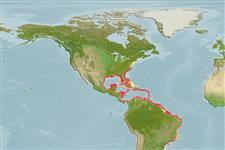Environment: milieu / climate zone / depth range / distribution range
Ecologie
marien; zoet water; brak water rifbewoner; diepte 2 - 40 m (Ref. 58047), usually 5 - 30 m (Ref. 9710). Subtropical; 42°N - 26°S, 98°W - 14°W (Ref. 55232)
Western Atlantic: Massachusetts, USA to São Paulo, Brazil (Ref. 57756), including the Gulf of Mexico and the Caribbean Sea (Ref. 9626). Eastern Atlantic: St. Paul's Rocks and Ascension Island (Ref. 13121), Tinhosa Grande, south of Príncipe Island (L.A. Pereira (pers. comm.).
Lengte bij maturiteit / Grootte / Gewicht / Leeftijd
Maturity: Lm 32.4, range 31 - 36 cm
Max length : 128 cm TL mannelijk / geslacht onbekend; (Ref. 40637); common length : 60.0 cm TL mannelijk / geslacht onbekend; (Ref. 26938); max. gepubliceerd gewicht: 28.6 kg (Ref. 40637); max. gerapporteerde leeftijd: 33 Jaren (Ref. 115050)
Dorsale stekels (totaal) : 10; Dorsale zachte stralen (totaal) : 14 - 15; Anale stekels: 3; Anale zachte stralen: 8. Preopercular notch and knob weak. One of the pairs of canines in upper jaw notably enlarged, visible even when mouth is closed. Pectoral fins long, reaching level of anus. Scale rows on back rising obliquely above lateral line. Presence of a triangular bar between lower edge of eye and rear of mouth. Back and upper sides olive brown with bronze tinge, sometimes with narrow pale bars; lower sides and belly light reddish with a copper tinge. Young with a horizontal blue line below eye which breaks into a row of spots in adults.
Adults are common around rocky or coral reefs. Young are found in estuaries and occasionally enters rivers. Feed mainly on fishes and benthic invertebrates, including shrimps, crabs, gastropods and cephalopods.
Levenscyclus en paargedrag
Maturiteit | Voortplanting | Paaien | Eieren | Fecunditeit | Larven
Allen, G.R., 1985. FAO Species Catalogue. Vol. 6. Snappers of the world. An annotated and illustrated catalogue of lutjanid species known to date. FAO Fish. Synop. 125(6):208 p. Rome: FAO. (Ref. 55)
Status op de Rode Lijst van het IUCN (Ref. 130435: Version 2024-1)
Gevaar voor de mens
Reports of ciguatera poisoning (Ref. 55)
Gebruik door de mens
Visserij: commercieel; sportvis: ja; Aquarium: Publieke aquaria
Tools
Speciale rapporten
Download XML
Internetbronnen
Estimates based on models
Preferred temperature (Ref.
123201): 23.2 - 28, mean 25.8 °C (based on 522 cells).
Fylogenetische diversiteitsindex (Ref.
82804): PD
50 = 0.5000 [Uniqueness, from 0.5 = low to 2.0 = high].
Bayesian length-weight: a=0.01514 (0.01339 - 0.01711), b=2.97 (2.95 - 2.99), in cm total length, based on LWR estimates for this species (Ref.
93245).
Trofisch niveau (Ref.
69278): 4.4 ±0.3 se; based on diet studies.
Generation time: 11.0 ( na - na) years. Estimated as median ln(3)/K based on 1
growth studies.
Weerstandsvermogen (Ref.
120179): laag, minimale populatieverdubbelingstijd 4,5-14 jaar (K=0.10; tm=5.5).
Prior r = 0.28, 95% CL = 0.19 - 0.42, Based on 1 data-limited stock assessment.
Fishing Vulnerability (Ref.
59153): High to very high vulnerability (66 of 100).
Nutrients (Ref.
124155): Calcium = 11.5 [5.9, 19.1] mg/100g; Iron = 0.269 [0.156, 0.499] mg/100g; Protein = 19.6 [18.0, 20.9] %; Omega3 = 0.176 [0.097, 0.305] g/100g; Selenium = 28.8 [13.9, 56.2] μg/100g; VitaminA = 96.7 [15.9, 482.1] μg/100g; Zinc = 0.254 [0.176, 0.396] mg/100g (wet weight);
